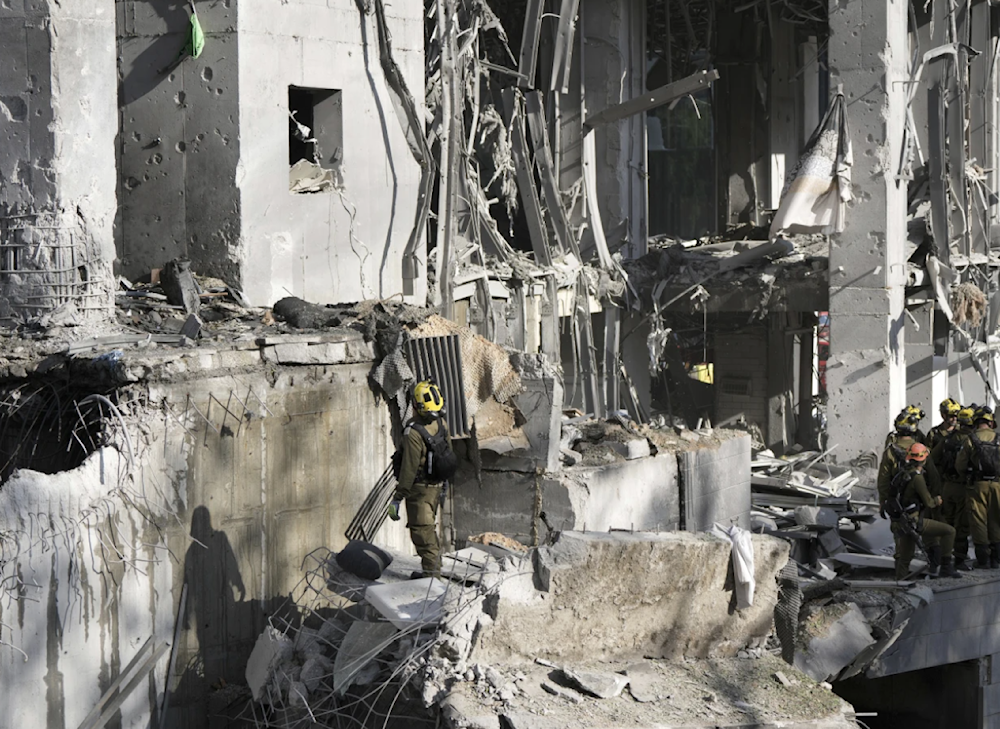'Israel' is firing interceptors faster than it can produce them: NYT
Although "Israel" possesses a world-class missile defense system, its supply of interceptors remains limited.
-

Rescue workers and military personnel inspect the site of a direct hit from an Iranian missile strike in Ramat Gan, occupied Palestine, on June 19, 2025 (AP)
Beyond the potential game-changing impact of a US military intervention, two key factors will likely determine the duration of the Israeli war on Iran: the number of long-range missiles Iran possesses and "Israel’s" stockpile of interceptors, The New York Times reported.
According to the American daily newspaper, "Israel" is depleting its interceptors faster than it can produce them, prompting growing concern within the Israeli security establishment. According to eight current and former officials, there is rising anxiety over whether "Israel’s" supply of air defense missiles will run out before Iran exhausts its missiles.
Already, the Israeli military has begun prioritizing the protection of densely populated areas and critical infrastructure, according to those officials, most of whom spoke on condition of anonymity.
“Interceptors aren’t grains of rice,” said Brig. Gen. Ran Kochav, a former commander of "Israel’s" air defense and a current military reservist. “The number is finite.” Conserving interceptors is a "challenge", he divulged.
As Iran continues to strike inside occupied territories, "Israel" is rapidly depleting its air defense resources. By Wednesday morning, Iran had launched approximately 400 missiles, of which around 40 penetrated Israeli defenses and struck targets, the NYT claimed.
Since multiple interceptors may have targeted some missiles, the total number used remains unknown. Israeli officials have declined to reveal how many interceptors remain, citing national security concerns.
This attritional missile exchange is testing both sides’ endurance. "Israel’s" capacity to sustain a prolonged war could hinge not only on interceptor reserves but also on whether President Trump chooses to escalate the war by attacking Iran’s Fordow nuclear site, or whether Iran halts enrichment to avoid US involvement.
'Israel’s' air defenses layered, but strained
"Israel's" air defense relies on a layered system of at least seven technologies designed to intercept threats at various ranges and altitudes. These systems are largely automated, using radar to detect incoming missiles and offering interception suggestions to operators, though in some cases, officers must decide without automated guidance, according to Brig. Gen. Ran Kochav.
For long-range threats, the Arrow system engages missiles at high altitudes, while David’s Sling handles them at lower altitudes. The Iron Dome is used primarily for short-range rockets, often from Gaza, or for debris from intercepted missiles. The US has also provided at least two additional systems, including ship-based interceptors in the Mediterranean. "Israel" is simultaneously testing a new laser-based defense system, and fighter jets are tasked with taking out drones.
Despite these robust defenses, the toll is mounting. Iranian missiles still struck their intended targets directly. With "Israel’s" missile interceptors in limited supply, there’s growing concern that the military may soon have to ration their use, reserving them for key sites like the Dimona nuclear facility or military command centers in Tel Aviv.
Launchers, not missiles, are Iran's strength
Some Israeli officials believe "Israel" should now capitalize on recent military successes. “Israel has a window of two or three days to declare the victory and end the war,” said Zohar Palti, a former senior Mossad officer. The longer the war drags on, the greater the risk that "Israel’s" defense systems will be overwhelmed.
Some Israeli officials and military analysts believe the key to neutralizing Iran’s missile threat lies not in depleting its stockpile, but in eliminating its ability to launch them. Iran relies on a mix of fixed and mobile missile launchers, many of which are spread across the country, with some stored in underground bunkers and others in exposed aboveground caches, according to two Israeli officials.
So far, "Israel" alleges to have destroyed more than a third of these launchers, a figure US officials say has significantly reduced Iran’s capacity to conduct large-scale missile barrages. The strikes have allegedly disrupted Iran’s launch infrastructure more than its missile inventory itself.
but fact on the ground suggest otherwise. Just this morning, Iran's Islamic Revolution Guard Corps (IRGC) carried out the 14th wave of strikes targeting strategic sites in the Israeli occupation entity as part of Operation True Promise 3. Israeli media described the attack as "the largest Iranian missile barrage on Israel in recent days," which debunks the claim that "Israel's" strikes on Iran significantly reduced Iran’s capacity to conduct large-scale missile barrages.
Asaf Cohen, a former Israeli military intelligence commander, said the main issue is the number of launchers rather than the number of missiles.
Cohen added that Iran may shift tactics, opting for sporadic harassment strikes involving one or two missiles at a time, targeting multiple areas to stretch Israeli air defenses.

 5 Min Read
5 Min Read









